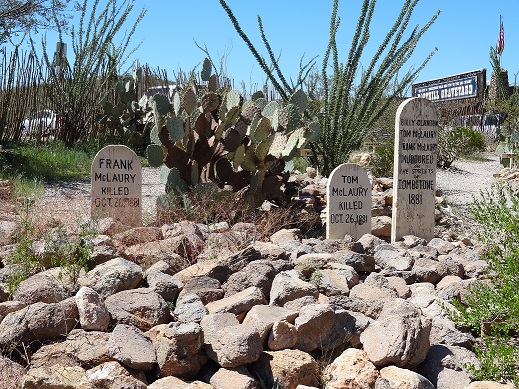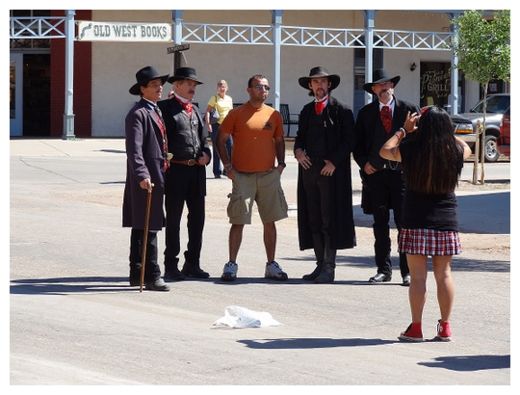
Minutes later, three men would be dead, and the four men who had walked to the corral and killed them - Tombstone marshal Virgil Earp, his brothers Wyatt and Morgan, and Wyatt's friend Doc Holliday - had unknowingly secured their places in history.
The Gunfight at the OK Corral is arguably the single most famous incident in the Old West. But what was it about? And why has it, above all the many other gunfights that took place in the era of frontier justice, achieved such infamy?
To understand the gunfight, you have to first understand the town. Tombstone in 1881 was a thriving, bustling silver mining community.
"There's a huge misconception about Tombstone in the 1880s: that it was a violent, dangerous place," says local author and historian Don Taylor. "It was extremely sophisticated and massively wealthy. Thirty-seven million dollars in 1880s dollars of silver was mined here; that's $8.25 billion today. They had everything.
"They had fresh seafood every day. They would catch it in Baja California; pack it in barrels of salt, ice and seaweed at dusk; freight it by train to Benson or Contention City, immediately pack it on to wagons and bring it here by dawn every day. It was a very opulent town. But again, people don't understand - especially if they come today - Tombstone was open 24 hours a day.
The miners worked rotating 10 hour shifts; everything had to be open when they got off, including banks. They were also pumping 2.5 million gallons of water out of the mines every day to keep them dry; so you had all the mining activity, all the milling activity, all the water rushing down Toughnut Street, and the town open 24 hours a day. It must have been noisy as hell."
As the mines thrived, so did all manner of supporting businesses: banks, bars, restaurants, hotels - and prostitutes, many of whom worked out of small 'cribs' that lined Sixth Street. The riches to be, had attracted plenty of would-be entrepreneurs -- among them Wyatt, Virgil, Morgan, James and Warren Earp, and Doc Holliday.
Both Virgil and Wyatt had been lawmen; Virgil had recently been appointed deputy marshal for the part of the Arizona Territory that included Tombstone, and although some record-keeping at the time was poor, it is possible that Wyatt may have been a deputy marshal as well.
Certainly, it appears as if all the brothers were anxious to join the list of those profiting from Tombstone's booming business: they invested in one of the mines, James tended bar, Wyatt rode as a stagecoach guard and dealt faro - the popular card game of the time - in a local saloon.
But Tombstone's growth and growing sophistication grated with one segment of society: the 'cowboys', a loose confederation of ranchers and cattle rustlers. The cowboys - who were predominantly rural, southern Confederates - eyed the primarily Yankee mercantile class that was dominating Tombstone, and which the Earps typified, with suspicion. And the feeling was mutual.
It didn't take long after the Earps' arrival in late 1879 for tensions between them and the cowboys to develop, particularly with Virgil and Wyatt spending time in law enforcement positions. That tension reached boiling point when Wyatt helped in the identification and arrest of some cowboy members in a pair of stagecoach robberies, and the cowboys in turn asserted that Wyatt and Holliday had in fact been the ones responsible for the holdups.
On the night of Oct. 25, 1881, one of the cowboy leaders, Ike Clanton, got into a heated, drunken argument with Holliday, and the next morning he wandered drunkenly up and down Allen Street, threatening to kill him and the Earps. A series of confrontations steadily escalated until Virgil was informed that a group of armed cowboys had gathered outside Fly's Boarding House - where Holliday was living - in a vacant lot close to the OK Corral.
Carrying guns inside city limits was a violation of a town ordinance, and it provided Virgil, who was now town marshal, with an opportunity to arrest the cowboys. But there may also have been other considerations at play.
As the self-identified Dr. Jay, who leads historical tours of Tombstone, explains: "Ike Clanton had openly threatened to kill the Earps. And why are they in that alley? Because it's right outside Fly's Boarding House. So if you're Doc Holliday, you show up and here's a bunch of guys with guns outside your house. You might want to think about, 'Are they going to get me tomorrow if I don't get them today?'"

"Throw up your hands," shouted Virgil as they reached the alleyway's entrance. "I mean to disarm you."
There was a pause, and the click-click of a gun - or guns - being cocked.
"Hold on, I don't want that!" shouted Virgil, but it was too late.
There were two shots fired simultaneously - it is uncertain by whom - and then, as Wyatt later testified, "the fight then became general."
Ironically, Ike Clanton, who had instigated the confrontation, fled the scene, grabbing Wyatt and screaming that he was unarmed.
"The fight has commenced," snarled Earp. "Get to fighting or get away." Clanton promptly took off, as did another cowboy, Billy Claiborne.
Within seconds, two of the cowboys - Tom McLaury and Billy Clanton - lay mortally wounded, Virgil Earp had been shot in the calf, and Morgan Earp shot through the shoulder blades. A third cowboy, Frank McLaury, shot in the stomach, staggered into Fremont Street and leveled his gun at Holliday.
"I've got you now," he said, mistakenly believing Holliday was out of ammo.
"Blaze away," taunted Holliday. "You're a daisy if you do."
At that point both Holliday and Morgan Earp fired almost simultaneously; bullets from one or both of their guns struck McLaury in the head, killing him.
The entire gunfight lasted approximately 30 seconds.

A hundred and thirty years later, the gunfight has been the focus of numerous motion pictures, and a part of many more - and was even pivotal to an episode in the original series of Star Trek. So we ask again: why has the slaying of three men on a misdemeanor firearms violation endured through history?
Don Taylor offers one explanation. "In January 1881, (Tombstone mayor) John Clum joined the brand new Associated Press," he explains. "So everything he wrote went to San Francisco, Chicago, New York. Everybody knew what was going on here."
There was also, explains Tim Fattig, who works as a tourist guide at the OK Corral and has written a voluminous biography of Wyatt Earp, another factor: the fact that the gunfight did not mark the end of the Earp-cowboy feud.
On Dec. 28, 1881, Virgil Earp survived an assassination attempt, but lost the use of his left arm. The following March, Morgan was gunned down and killed while playing billiards.
In revenge, Wyatt, Warren Earp, Holliday and others set out on a "vendetta ride" for justice, in which they killed at least three cowboys, including the faction's de facto leader, Curly Bill Brocius.
"It was the vendetta ride that truly elevated the gunfight in public perception," Fattig says. "The idea of a brother gaining revenge for one brother's murder and another being wounded is compelling."
That's one reason why Wyatt Earp dominates the history books and the mythology at his brothers' expense: he was the one who led the ride for vengeance. There is also another reason: In 1931, two years after Earp's death, author Stuart Lake published Wyatt Earp: Frontier Marshal, a hagiographic account he had produced with Earp's collaboration. After that came the movies - My Darling Clementine, Gunfight at the OK Corral and more - and the TV series, including The Life and Times of Wyatt Earp.
Wyatt is lionized above the others, in other words, because he outlived them all, and got to tell his story. The rest, as they say, is history.



All you can really know about it is
That it didn't happen like the "official story" says it did.
R.C.